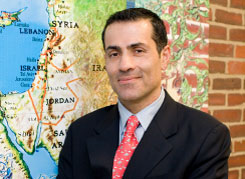
Today’s organized youth sports sometimes prevent children from developing a love for the game—and that’s counterproductive. Photo: iStock
Ask The Professor
What are the do’s and don’ts of being a sports parent?
This month’s expert, W. George Scarlett, deputy chair of the Eliot-Pearson Department of Child Development, responds:
There was a time not too long ago when backyard sports commanded more of children’s time and energy than youth sports organized by adults. In backyard sports, children themselves chose teams and modified rules. They played the games if not with civility, then at least with gusto. From street ball in crowded cities, to sandlot ball games in suburbs, to basketball played against barn doors in the country, sports for kids really did mean sports for kids—and kids loved it. They loved the sports they played, loved the friendships they made and loved being left alone by adults.
No more. Today’s shift to organized youth sports has brought with it elite teams and club sports, where performance and winning matter most. Children are subject to drafts and tryouts, which sometimes separate friends who want to be on the same team. Also, commitments to a team often limit children’s ability to play a variety of sports and do other things.
While most children have lots of fun in organized youth sports, and most sports parents behave themselves and support their children, I do have some concerns, and some sports-parenting suggestions.
Most important is simply to be aware that today’s organized youth sports sometimes prevent children from developing a love for the game. Children around eight or nine are ready to fall in love with a sport, and parents do them a tremendous disservice by acting in ways that prevent that from happening—such as coaching from the sidelines (kids hate it). Another powerful turn-off is the parent who, as an official volunteer coach, favors star players at the expense of the less skilled.
Second, parent volunteer coaches need to really learn how to coach. My sport is baseball, and I’m always amazed that so many Little League coaches know so little about the essentials of hitting, throwing, pitching and fielding—things such as how to grip a bat and where to place a glove when catching a fly ball. As a result of such ignorance, children don’t improve their game, which they want to do. Worse, some become increasingly frustrated. Coaches yell out commands that don’t help—“Swing hard! Stay focused!” and the like—and kids get the message that if they fail, it’s because they aren’t trying hard enough.
Third, parents of children who are doing well in organized youth sports should not project too far into the future. When Mom and Dad fantasize that their child will be on a high school varsity team, obtain a college athletic scholarship or perhaps even compete in the Olympics, play can easily turn into pressured work. And disappointments may well ensue when the child reaches puberty and finds out that being a star at nine or 10 predicts little about athletic performance years later. Tiger Woods is the exception, not the rule.
Fourth, parents should make sure organized youth sports don’t replace backyard sports altogether. They need to do what they can to promote backyard sports, even if that means simply playing catch with their child. Again, backyard sports are where children nurture their love for the game, and it’s developing this love that is most important.
W. George Scarlett is deputy chair of the Eliot-Pearson Department of Child Development in the School of Arts and Sciences and lead author of the books Children’s Play (Sage, 2004) and The Baseball Starter: A Handbook for Coaching Children and Teens (McFarland & Co, forthcoming in 2009).
Have a question for “Ask the Professor”? E-mail taylor.mcneil@tufts.edu.


